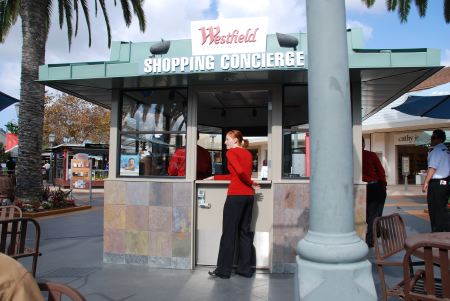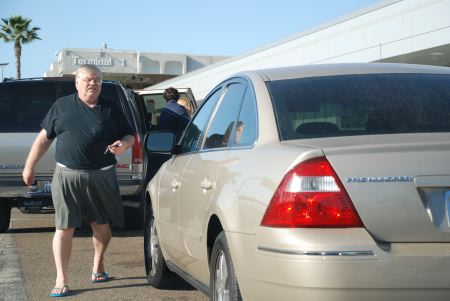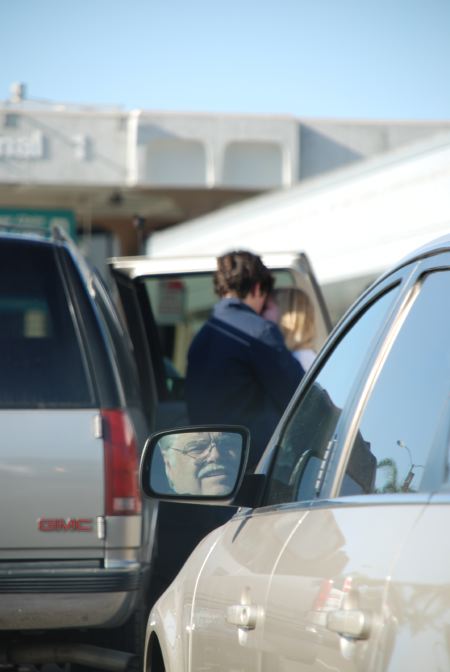Why paint? (part ii)
November 27th, 2006
I’m in San Diego. I will spare you the ten million sunset photos, the paraglider photos, the wave and ocean photos, the nifty rock formation photos. Below are some images straight off the camera which I find interesting.
. . .
(click images below to enlarge)
. . .
. . .
. . .
Here the man we saw in the previous photo is sitting in his car looking at the couple ahead of him. We see him in his mirror. Not great, but sort of neat. The point is, this would be a tough one to get with plein air painting.
[UPDATE: As I mentioned, these are jpeg files straight from the camera (only reduced in size). If you would like to work with these files further (or the 4 MB originals), please feel free to do so and use the results for any purpose you wish. If you create something interesting with them, I’d be interested to hear about it.]



November 27th, 2006 at 11:29 am
Karl,
I love that last one! It reminds me of Lee Friedlander’s photos (there are many at http://www.moma.org) that have frames within frames, but with a psychological edge. This guy is a voyeur, but where else is he supposed to look? I am a big fan of snapshot type photos, less carefully controlled compositions, “slice of life…” Maybe they are less technically adept, but they are compelling to me. Leslie
November 27th, 2006 at 11:53 am
Hey, and what’s wrong with the nifty rock formations :-)
The point is, this would be a tough one to get with plein air painting
That is presumably true of any image which is dependent on a small slice of time…..for despite disagreeing with you that photographs are necessarily tied to a moment, it is the case that they are often tied to a moment.
I also wonder whether, if this (pic 3) were a painting, we would be saying that the face had been rendered too large. There is something TV like about that face/rectangle.
A question for you, Karl. Do you think that looking for moments like the ones you have recorded here would change what you chose to paint?
November 27th, 2006 at 11:54 am
this would be a tough one to get with plein air painting
Even if you did capture this in a painting, plein air or otherwise, it wouldn’t have the same impact. Despite the fact that we know photos can be manipulated, I think our first tendency is to accept them as glipmpses of reality. If this were a painting, you could expect comments like “that guy’s face is too big to be a reflection”, or “the guy in the background looks like he’s reaching through the side window of the front car”. But since it’s a photograph, we just figure that’s what was there. And the anomalies read as interesting finds rather than mistakes.
November 27th, 2006 at 11:57 am
Oh wow, it looks like Colin and I were writing at the same time, and he said the same thing about the face :)
November 27th, 2006 at 12:22 pm
David,
We must stop meeting like this :-)
November 27th, 2006 at 12:35 pm
A question for you, Karl. Do you think that looking for moments like the ones you have recorded here would change what you chose to paint?
Colin, I mentioned earlier that as a painter I felt threatened by photography. My avoidance of photos (even looking at them) bordered on fanatical. To illustrate, a couple of days ago I was in my father’s office at UCSD. There was a photograph of a small child. I said “Who is that?” My father said, “That is your daughter at the age of one.”
Colin, I have probably looked at my daughter as closely as anyone has ever looked at their own child, because I have studied her for years with life drawing and sculpting. But I did not recognize her in the photo because I never made photos of her and I went to great lengths to avoid seeing them. This is because I wanted to have a pure, non-photographic vision, which is what I used in this painting, for example. (By the way, the painting is a collaborative work with Hanneke van Oosterhout).
I did not pick up the camera lightly when I began with this a week or so ago. I knew it would have profound effects on me. To answer your question from the perspective of this moment, I don’t think I could paint in the same way ever again. I don’t know what the future will hold, of course.
I am not going anywhere near a paintbrush for the time being.
. . .
David,
Playing around with the computer informed me immediately that what comes out of the camera and what I can make of it with editing are worlds apart. For the moment, I’m more interested in what I can do with the camera as a tool in itself. If I constructed the face in the mirror with editing, it would lose it’s impact to some degree, if one were aware of the fact.
Leslie,
I imagine photographers are like fishermen with “big one that got away” stories. If you only could have seen what happened outside “Terminal 1” after I made these pictures and the camera was full!
November 27th, 2006 at 1:18 pm
For the moment, I’m more interested in what I can do with the camera as a tool in itself. If I constructed the face in the mirror with editing, it would lose it’s impact to some degree, if one were aware of the fact.
Ah, I wasn’t suggesting that you should (or did) change the photo. Was really just commenting on the different way we view a photo, as compared with a painting. It’s related to the way we look at the world, which we tend to think of photos as objective views of (even if we know better). My painting teacher once asked “why don’t we ever look at a cow and say the spots are in the wrong place?”
Also, why have you been avoiding looking at photos. Have you avoided looking at buildings w/ electric lights or at roads that had cars in them? When you moved from the US to Europe did you sail on a wooden ship? How was avoiding photos keeping your vision pure?
November 27th, 2006 at 1:22 pm
what happened outside “Terminal 1″ after I made these pictures and the camera was full!
You probably already know this, but if you have an iPod there’s a little attachment you can buy that let’s you download your photos to it. It’s basically just a little portable hard drive (the iPod). Once you do that you can clear the memory on your camera and keep shooting. You can transfer the photos from the iPod to your computer later.
November 27th, 2006 at 2:24 pm
what happened outside “Terminal 1″ after I made these pictures and the camera was full!
Memory cards are cheap. Batteries are cheap. Film is cheap. You can never have too much of any of these.
You’ll know that you are really hooked when you start carrying a second camera in case the first one fails (which it will, probably at the most inconvenient moment).
November 27th, 2006 at 3:25 pm
When I am traveling, my husband has a camera and I draw and paint. I have captured many momentary memories directly on paper. The more I do it the more they flow. It feels so good to make these renderings. Drawing is an immediate way to connect with people. I am so alive with little technology between me and my little statements. And I can write on my drawings to better remember. It really is easy as compared to taking photographs once I became skilled at it. I am sorry I feel the the couple kissing between cars is contrived.
November 27th, 2006 at 8:23 pm
When I am traveling, my husband has a camera and I draw and paint. I have captured many momentary memories directly on paper.
To extend on Diane’s comment, photographer Jay Dusard once commented that if he had plenty of time to capture a scene, he set up his camera. If he didn’t have time for that, he made a sketch.
I imagine photographers are like fishermen with “big one that got away” stories. If you only could have seen what happened outside “Terminal 1″ after I made these pictures and the camera was full!
Gary Winogrand, one of the best known street photographers, was once asked how he felt about the photographs he missed while he was reloading his camera with a new roll of film. He replied “There are no photographs while I’m reloading.”